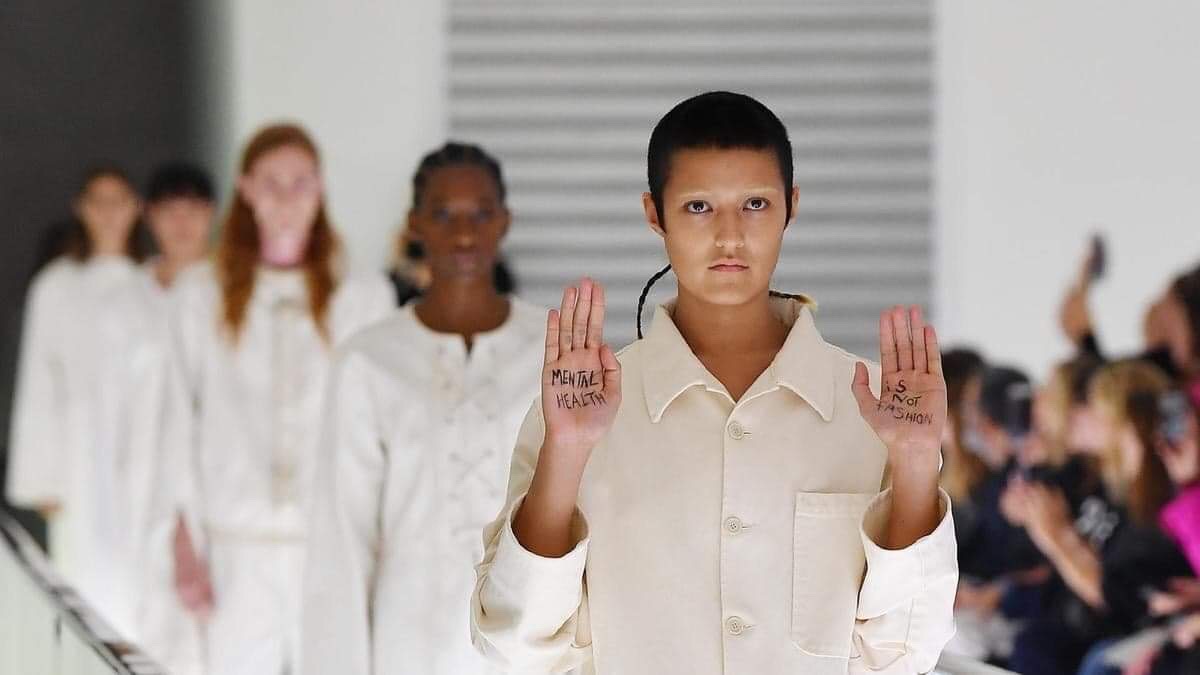Lizzie Wright and Iona Tompkins discuss Gucci’s controversial catwalk show, which sparked media attention across the globe.
The Gucci S/S show at Milan Fashion Week has been rocked with controversy after a model spoke up against the designs presented – which were designed to mimic straitjackets – while they were walking in the show. Ayesha Tan-Jones, who identifies as non-binary, held up their hands during their walk to display the words ‘mental health is not fashion’. In a statement posted to Instagram, they explained their decision, saying:
As an artist and a model who has my own struggles with mental health, as well as family members and loved ones who have been affected by depression, anxiety, bipolar and schizophrenia, it is hurtful and insensitive for a major fashion house such as Gucci to use this imagery as a concept for a fleeting fashion moment.
Gucci have had a landmark year: creative director Alessandro Michele was on the committee for this year’s Met Gala, and many of his designs were worn by celebrities such as Jared Leto, Florence Welch, and Harry Styles, who also became the new face for the brand. Gucci have long been revered for their signature designs and have enjoyed a recent emergence as a sought-after brand for young people thanks to the 90s trends. The fact that in 2019, when mental health has never been such a prevalent issue as it is today, Gucci chose to put out a runway show featuring models dressed in pieces clearly resembling straitjackets is not only disgusting, it is disappointing. This isn’t their first brush with controversy however – in February a jumper said to resemble blackface was removed from sale after complaints. Gucci are a powerful presence, so to see them put out something so distasteful is a hit to their respected reputation; such a highly popular brand should have thought about the implications of what they present, especially at events like Milan Fashion Week where the whole fashion world is watching. Tan-Jones was right to protest about the designs, especially during the show, with the way the pieces were displayed – with the models standing motionless on a moving walkway – making the scene all the more concerning. Not only were the models themselves used as empty props (no more lifelike than mannequins, which defeats the purpose of the runway), but the human experience was exploited; straitjackets are not, and should never be, fashionable.
Gucci responded to the controversy on Instagram, saying:
‘Uniforms, utilitarian clothes, normative dress, including straitjackets, were included in the #GucciSS20 fashion show as the most extreme version of a uniform dictated by society and those who control it. These clothes were a statement for the fashion show and will not be sold.
@alessandro_michele designed these blank-styled clothes to represent how through fashion, power is exercised over life, to eliminate self-expression.’
It is disappointing that a creative mind such as Alessandro Michele was unable to find any other way to express the idea of being controlled and turned to utilising a stark symbol of society’s misunderstanding of the mental health struggle in order to sell clothes. Straitjackets were often used to torture or punish inmates in mental asylums, and it is shameful to see them being used in our capitalist culture to make money. Mental illness is everything fashion aims not to be; fashion labels want to appear beautiful and desirable. While provocativeness has long been a tactic used to entice buyers, Gucci failed to toe the line between shocking and downright offensive, choosing instead to jump straight across it.
Lizzy Wright
Whilst Ayesha Tan-Jones’ protest was poignant and extremely powerful, this issue raises a wider debate about whether Gucci should ever be allowed to send designs like these down their catwalks. Had the company perhaps gone about the subject matter in a different manner, the reaction might have been completely different. If the fashion house had spoken to their models and everyone else who worked on the collection before the show and explained why they thought it was a necessary statement to make, it is likely the models would have felt part of a wider conversation rather than simply being used for their hanger appeal.
However, if issues of mental health were personal to one of the collection’s designers it is perhaps understandable that they may have wanted to iterate these feelings implicitly through art rather than in an explicit statement. Perhaps the individual feels they are able to convey greater nuance through fashion than they are in spoken word, and this collection is their medium for expressing themselves. Designers that are now lauded have generally had their fair share of controversy, and we must simply wait and see if this is to also be the case for Alessandro Michele. Alexander McQueen is most notable for this, with collections featuring women who deliberately looked as if they’d been raped (Highland Rape, A/W 1995) or having a black model walk down the catwalk in metal shackles strongly reminiscent of the slave trade ( S/S 1997). Whilst at the time these where viewed critically by many, today McQueen’s collections have formed the V&A’s most successful exhibition to date, and his fashion house has dressed Kate Middleton for her wedding day.
Controversy has long been the bread and butter of fashion, as boundaries are pushed in order to see if something new can be achieved. Only time will tell if this collection marks Gucci’s downfall, or secures its place in fashion history.
Iona Tompkins

